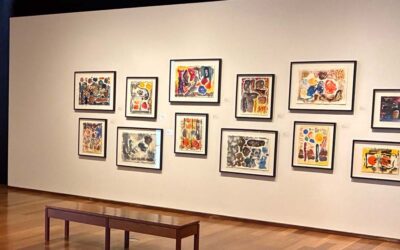Museum TrendsWatch 2023: Repatriation, Restitution, Reparations

Rachael Cristine Woody
Each year the Center for the Future of Museums (under the auspices of the American Alliance of Museums) publishes a TrendsWatch report. Each year, I provide an analysis of the issues therein via a series of posts.
This year the report is titled TrendsWatch: Building the Post-Pandemic World and includes six trends: The Future Workplace, A Digital (R)evolution, The Partisan Divide, Repatriation, Restitution, Reparations; The Metaverse and Web 3.0; and Changing Climate Risk. Today’s post is Repatriation, Restitution, Reparations. As a note, the Center did not create a full TrendsWatch article for this topic. Instead, they are calling it a “Short Take”.
Summary
This section begins with the statement that values specific to rectifying past collecting practices are radically shifting. Collection items that have been unethically sourced—either through war, looting, and colonialism—should be considered for repatriation or restitution. In the last decade there’s been, as the Center describes: “an avalanche of legal battles, legislative action, and community outcry.” Several landmark policy shifts have come from cultural leaders and museum heavy-weights, such as:
- The Restitution of African Cultural Heritage in 2018, commissioned by the French President Emmanuel Macron inspired museums in the western world to reconsider their possession of looted Benin artifacts.
- The Canadian Museums Association released a report encouraging museums to take a proactive approach to repatriation.
- Also in 2022, the Smithsonian Institution (under Secretary Lonnie Wright), changed its policies and transferred 29 Benin Bronzes to the National Commission for Museums and Monuments in Nigeria.
Related Read: Museum TrendsWatch 2019: Decolonization
Overall, these efforts can be gathered under the umbrella of a “Do the Right Thing” sentiment. The Center goes on to state that legislation is likely to shift from protecting institutions to supporting claimants’ rights. This anticipated legal and ethical shift is reflected in my own Museum Forecast 2023 — Repatriation is No Longer Optional post, summarized below:
My forecast is that repatriation will no longer be optional. First, through ethical “peer pressure” and then followed by laws, museums will be forced to reconcile with decades worth of poor collecting practices and anemic provenance research. The proposition is no longer: Will the museum choose to repatriate? Instead, it’s: How will the museum arrive at repatriation? Will the museum administration offer it proactively or at least cooperatively? Or, will museum administration balk at the request, act poorly, and submit to it only after legal actions and/or reputational harm have occurred?
While some museum heavy weights such as the Smithsonian and the MFA (Boston) are leading the way, we’re still going to see larger, longer established museums struggle to evolve. This will be especially true for museums where there’s not been a robust focus on repair work, ethical collecting practices, and a re-evaluation of its collection provenance. Smaller to moderate-sized museums will have their share of challenges too as lack of staff and expertise will hinder participation in provenance research and repatriation—not to mention the likely financial impact that comes from this work. This is an area where federal granting agencies could assist more robustly by offering financial recompense (and incentive) to support museums performing this ethical and necessary work.
Museums that are engaged in DEI work at a programmatic-level will be better able to meet opportunities of repair as they come. Joining with the MFA (Boston) and others, these museums will lead the way regarding repatriation and will subsequently reap the ethical, reputational, and (potentially) financial benefits.
A Short Exploration of Reparations
The Center closes their “Short Take” on Repatriation, Restitutions, and Reparations with a brief exploration of what reparations could look like for museums. It may not be enough to return artifacts to their rightful homes. There’s the damage done from those objects being removed and kept out of reach from their cultural home. Whether it’s repatriation, restitution, or reparations, the Center concludes that it is no longer “What is the museum allowed to do?” but instead “What should the museum do?”.
The Center’s Advice for Museums
The Center leaves us with the following considerations in the Museums Might… section.
- Audit museum collection policies and practices to ensure they’re in compliance with current laws (local, national, and international).
- Assess the collection provenance files and flag any items with unclear or concerning provenance.
- Engage with Board and Staff with the following prompts:
- Where is the museum on the legal compliance 🡪 voluntary repatriation 🡪 reparations spectrum?
- How can the museum cooperatively (and respectfully) work with communities who have a “moral, cultural, or legal claim to the collections”?
- Regarding values specific to “Who owns or controls cultural heritage?” where is there agreement and disagreement?
Conclusion
This is a huge topic and one I hope we see more thought leadership on from the Center. Until then, we look to the museums who are leading the way in repatriation, restitution, and reparations. And, we can learn from museums who are desperately clinging to the dominance of old practices and policies, to the detriment of everyone.

Rachael Cristine Woody
Rachael Woody advises on museum strategies, digital museums, collections management, and grant writing for a wide variety of clients. She has authored several titles published by Lucidea Press, including soon-to-be-released Prepare for Takeoff: Get Your Museum Digital Project off the Ground. Rachael is a regular contributor to the Think Clearly blog and an always-popular presenter.
Never miss another post. Subscribe today!
Similar Posts
From Preservation to Resilience: An Introduction to Building Resilient Digital Collections
Preserving a digital collection is a job that is never done. But what if we shifted our focus from preservation to building digital resilience?
Client Spotlight: MacLaren Art Centre Goes Beyond Collections Care to Access and Growth
“As our needs evolved, it became clear that our existing CMS was no longer working for us. Not only do we need to perform basic collections care, we need a system that will support public access, enable growth, and match our innovative strategies.”
Museum Collections Online: Digital Storytelling Blog Series Roundup
An overview of 10 blog post series that highlight how museums can leverage online collections and digital storytelling platforms, strategies, tools, and best practices.
How Museums Can Broaden Access and Improve Accessibility with Digital Storytelling
Museum expert Rachael Cristine Woody explains how digital storytelling expands access and improves accessibility of museum collections with inclusive multimedia formats.




Leave a Comment
Comments are reviewed and must adhere to our comments policy.
0 Comments